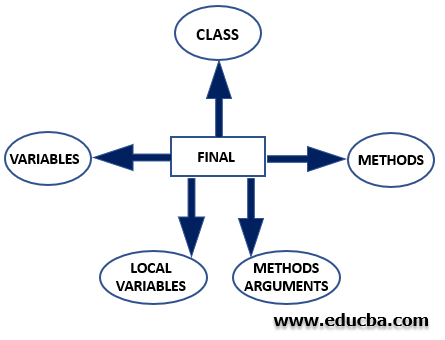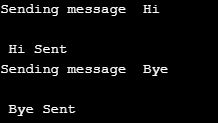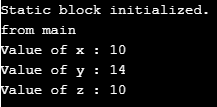非访问修饰符是 Java 7 中引入的关键字,用于通知 JVM 有关类的行为、方法或变量等的信息。这有助于引入其他功能,例如用于指示变量不能被初始化两次的 Final 关键字。总共引入了 7 个非访问修饰符。
以下是 Java 中非访问修饰符的类型:
广告 该类别中的热门课程 JAVA 掌握 - 专业化 | 78 课程系列 | 15 次模拟测试此修饰符可应用于:

代码:
final class Honda{
public void myFun1(){
System.out.println("Honda Class");
}
}
class Bike extends Honda{
public void myFun1(){
System.out.println("Bike Class");
}
}输出:

代码:
class Honda{
public final void myFun1(){
System.out.println("Honda Class");
}
}
class Bike extends Honda{
public void myFun1(){
System.out.println("Bike Class");
}
}输出:


代码:
public abstract class MyActivity{
public MyActivity(){
}
public final String myFun1(){
}
}示例: public abstract void fun1();
代码:
abstract class Electronics
{
abstract void display();
abstract void display(String msg);
}
class Computers extends Electronics
{
@Override
void display() {
System.out.println("Abstract method is called");
}
@Override
void display(String txt) {
System.out.println(txt);
}
}
public class AbstractDemo {
public static void main(String[] args) {
Computers obj=new Computers();
obj.display();
obj.display("Method with arguments");
}
}输出:


该关键字有助于防止多个线程同时访问一个方法,从而同步程序流程并使用多线程功能得出所需的结果。
代码:
class Person1
{
public synchronized void sendFun(String txt)
{
System.out.println("Sending message\t" + txt );
try
{
Thread.sleep(1000);
}
catch (Exception e)
{
System.out.println("Thread interrupted.");
}
System.out.println("\n" + txt + "Sent");
}
}
class DemoThread extends Thread
{
private String txt;
Person1 person;
DemoThread(String m, Person1 obj)
{
txt = m;
person = obj;
}
public void run()
{
synchronized(person)
{
person.sendFun(txt);
}
}
}
public class HelloWorld
{
public static void main(String args[])
{
Person1 snd = new Person1();
DemoThread S1 =
new DemoThread( " Hi " , snd );
DemoThread S2 =
new DemoThread( " Bye " , snd );
S1.start();
S2.start();
// wait for threads to end
try
{
S1.join();
S2.join();
}
catch(Exception e)
{
System.out.println("Interrupted");
}
}
}输出:


该变量用于内存管理,也是加载类时首先引用的变量。这些成员受到班级级别的待遇;因此,不能使用对象来调用它们;相反,类的名称用于引用它们。
Code:
public class Demo
{
// static variable
static int x = 10;
static int y;
//static class
public static class DemoInnerClass{
static int z=10;
}
// static block
static {
System.out.println("Static block initialized.");
y = x + 4;
}
//static method
public static void main(String[] args)
{
System.out.println("from main");
System.out.println("Value of x : "+x);
System.out.println("Value of y : "+y);
System.out.println("Value of z : "+DemoInnerClass.z);
}
}Output:


The native keyword is used only with the methods to indicate that the particular method is written in platform -dependent. These are used to improve the system’s performance, and the existing legacy code can be easily reused.
Note: Static, as well as abstract methods, cannot be declared as native.Example: Consider a function myfun1 in class NativeDemo that is written in C++. To use this code, we will create a link library mylib1 and load it using the class’s static block.
public class DateTimeUtils {
public native String getSystemTime();
static {
System.loadLibrary("nativedatetimeutils");
}
}
Code:
public class HelloWorld
{
public strictfp double calSum()
{
double n1 = 10e+07;
double n2 = 9e+08;
return (n1+n2);
}
public static strictfp void main(String[] args)
{
HelloWorld t = new HelloWorld ();
System.out.println("Result is -" + t.calSum());
}
}Output:

While transferring the data from one end to another over a network, it must be serialised for successful receiving of data, which means convert to byte stream before sending and converting it back at receiving end. To tell JVM about the members who need not undergo serialization instead of being lost during transfer, a transient modifier comes into the picture.
Syntax:
private transient member1;
Code:
import java.io.*;
class Demo implements Serializable
{
int x = 10;
transient int y = 30;
transient static int z = 40;
transient final int d = 50;
public static void main(String[] args) throws Exception
{
Demo input = new Demo();
FileOutputStream tos = new FileOutputStream("abc.txt");
ObjectOutputStream tin = new ObjectOutputStream(tos);
tin.writeObject(input);
FileInputStream fis = new FileInputStream("abc.txt"); ObjectInputStream ois = new ObjectInputStream(fis);
Demo output = (Demo)ois.readObject();
System.out.println("x = " + output.x);
System.out.println("y = " + output.y);
System.out.println("z = " + output.z);
System.out.println("d = " + output.d);
}
}Output:

Non-access modifiers are the type of modifiers that tell JVM about the behavior of classes, methods, or variables defined and prepared accordingly. It also helps in synchronizing the flow as well as displaying similar results from operations being performed irrespective of the platform used for execution.
This is a guide to Non Access Modifiers in Java. Here we discuss the Types of Non Access Modifiersand their methods and code implementation in Java. You can also go through our other suggested articles to learn more –
以上是Java 中的非访问修饰符的详细内容。更多信息请关注PHP中文网其他相关文章!




